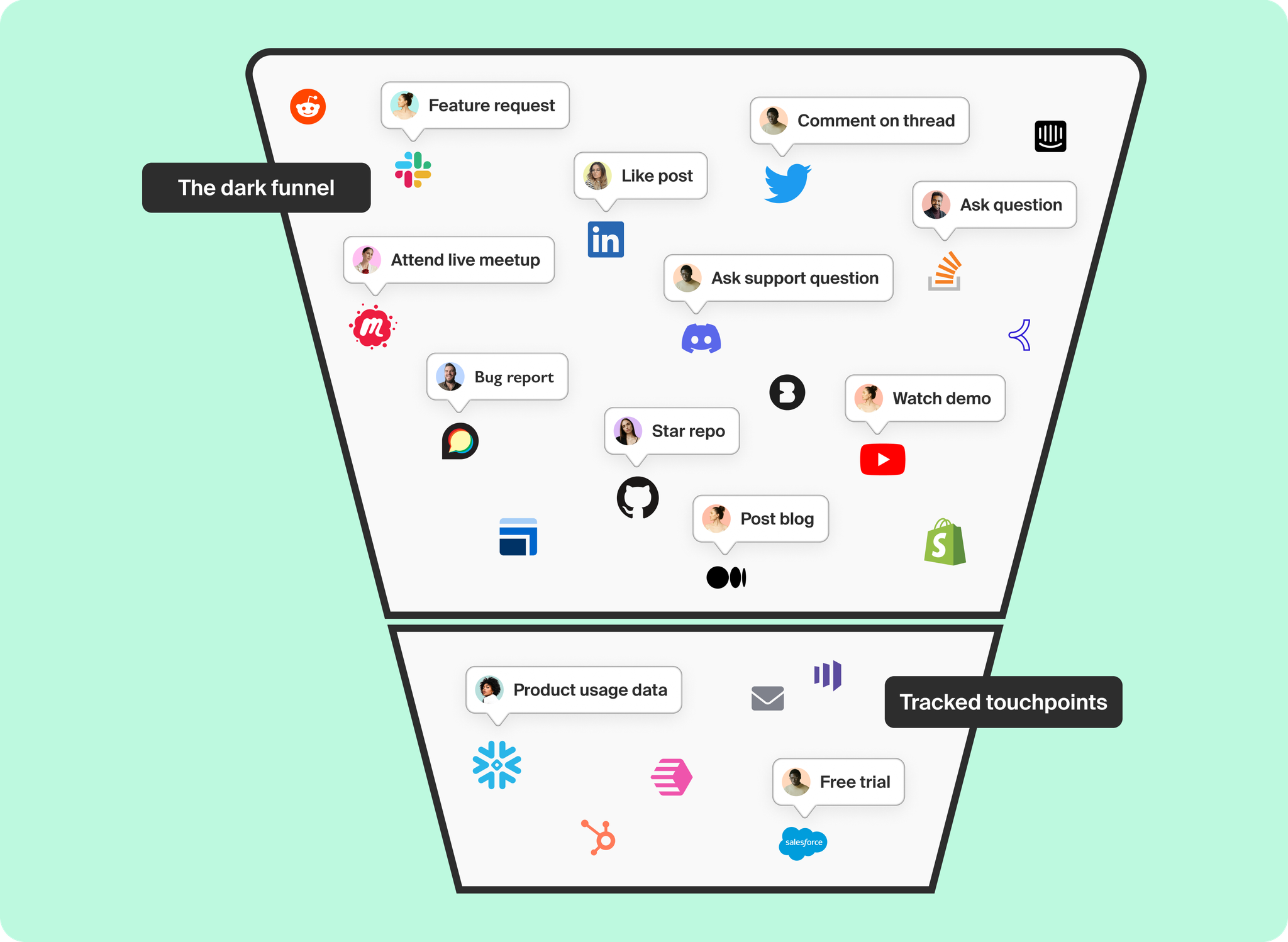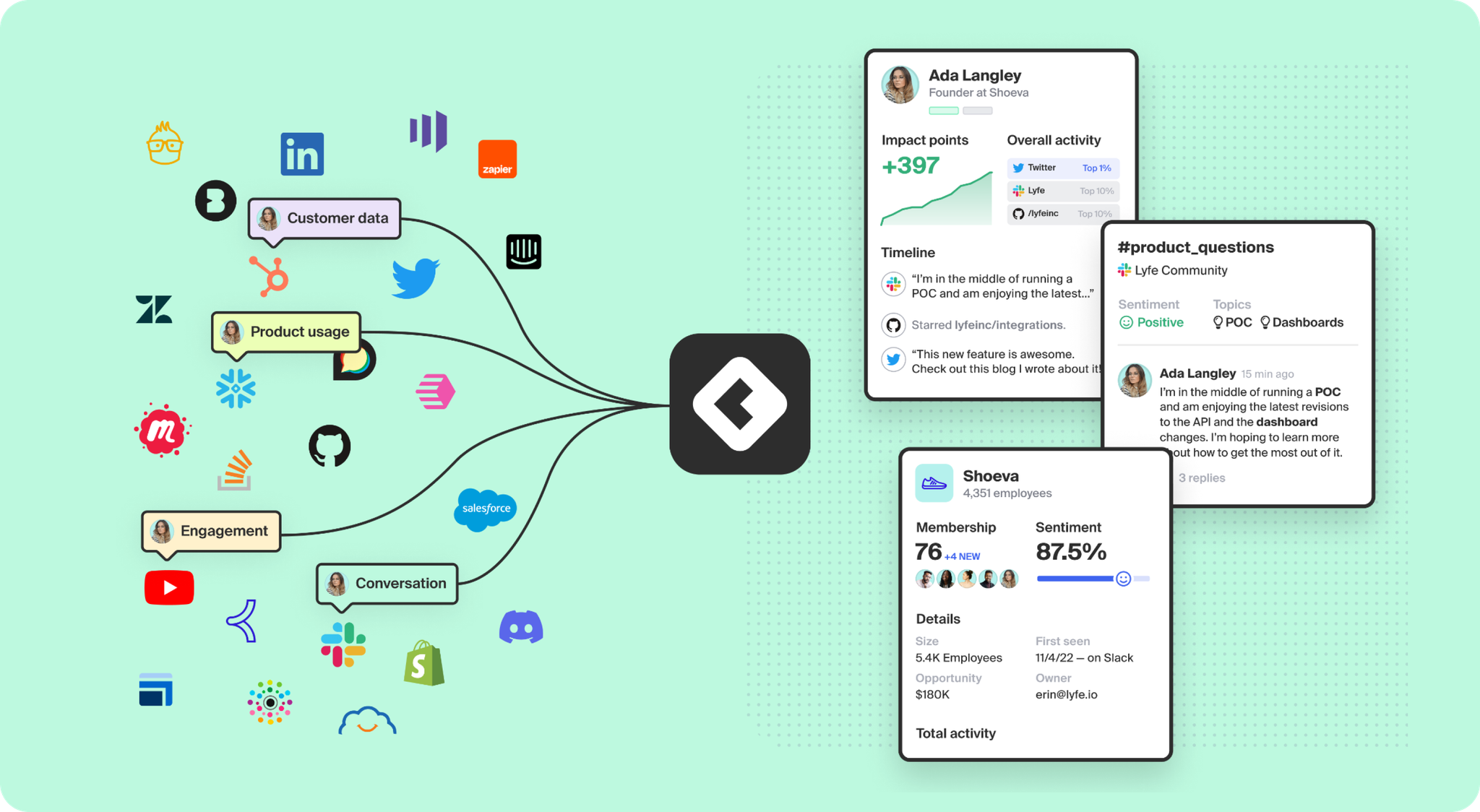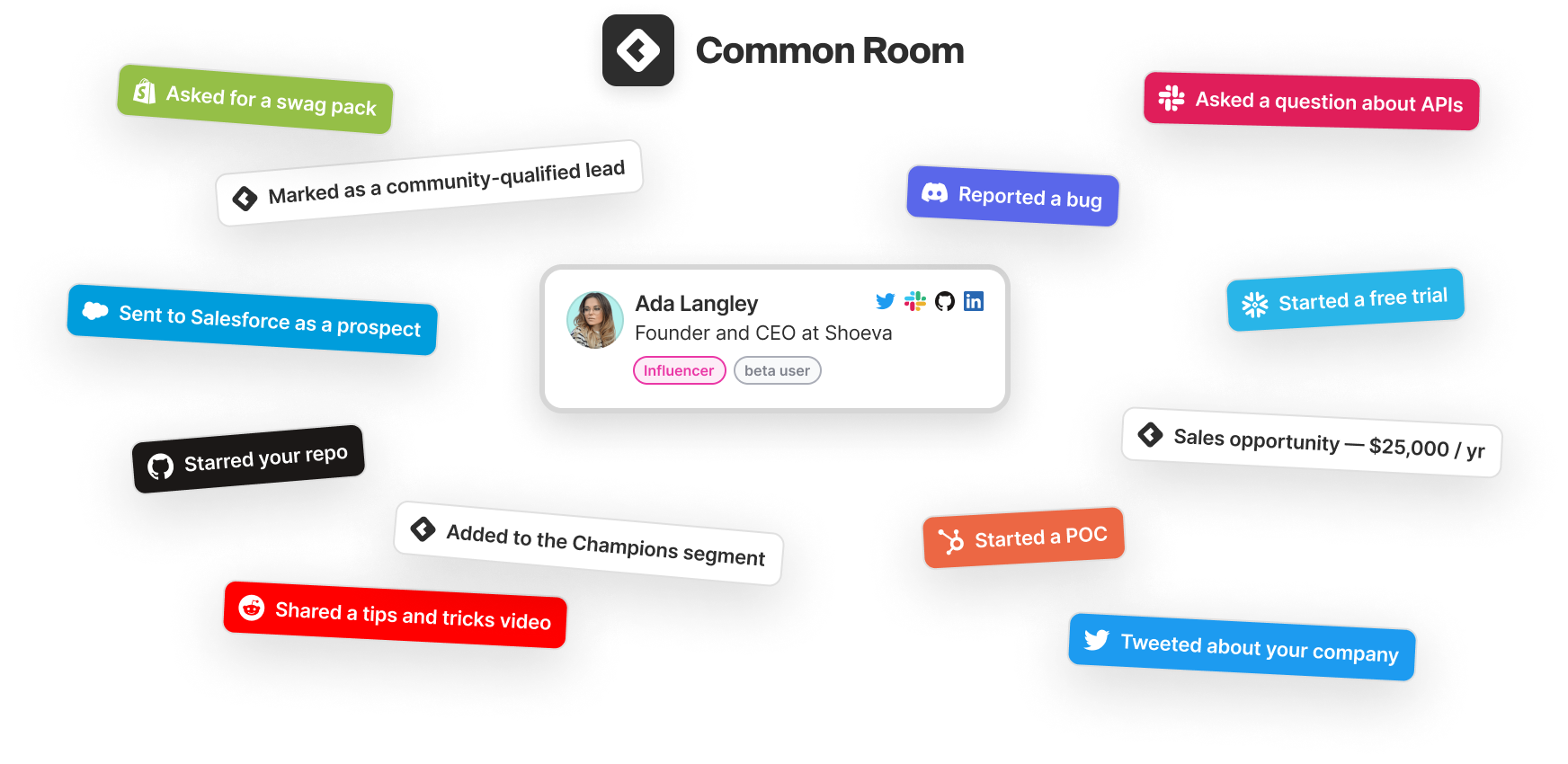Intent-based marketing promises to take data from online behavior to help you deliver targeted outreach to the right person, at the right time, and in the right context.
The problem? Traditional intent-based marketing comes up short.
Go-to-market teams are left combing through lists of accounts that performed a minor action (like reading a blog post and bouncing) with no insight into the person behind the account who actually performed the action.
And that’s where community comes in. Unlike traditional intent signals, community activity tells you what buyers are thinking, feeling, and talking about. Even better, it tells you who. Whether it’s a Reddit thread or a LinkedIn conversation, community surfaces are rich with intent-based insights.
This article will dive into:
- What intent-based marketing is
- Why intent data is especially important to B2B companies
- How to surface intent through community channels
- The role intelligent tooling plays in collecting intent data
- The core features of best-in-class intent tools
- Ways to harness intent from digital channels
What is intent-based marketing?
Put simply, intent-based marketing is when you execute on campaigns directed at real people whose online behaviors predict their purchase intent. It helps you surface and target higher-quality leads using context about where your buyers are in the funnel.
Say you’re a software company. You have data that tells you someone who works at a specific organization is exploring a competitor’s products or services. Using this intent data, you can proactively target that person with messaging about how your solution compares to the competition. And it doesn’t have to be complicated—it can be as simple as serving up a banner ad highlighting your product differentiators at a key moment.
Check out our conversation with Vercel and Lavender to see how go-to-market leaders think about the roles of intent and context in pipeline growth:
Why is intent data important for B2B companies?
Intent data—the information that reveals where a prospect is in the buyer’s journey and their likelihood of making a purchase—is especially helpful for B2B companies.
With longer and more complicated sales cycles, B2B companies need ways to optimize targeting, qualification, engagement, and more. Intent data makes all this (the bedrock of successful account-based marketing) possible.
The benefits of intent data for B2B
Some of the benefits of intent data for B2B companies include:
Improved targeting
Intent data provides insights into the behaviors of prospects, such as their content consumption and social media activity. B2B companies can use this data to identify the prospects most likely to become customers or champions so they can target them with appropriate messaging.
Increased sales efficiency
Intent data helps B2B sales teams focus on prospects that are actively researching solutions. This information helps them prioritize their sales efforts and avoid wasting time on prospects not yet ready to become customers.
Personalization
Intent data helps B2B companies tailor their messaging and content to individual prospects' needs and interests. Understanding what a prospect is looking for means you can provide a personalized experience, which helps build trust and increase engagement.
The risks of not using intent data for B2B
Without intent data, B2B companies often struggle with:
Less effective marketing
B2B companies struggle to launch effective marketing campaigns because of substandard targeting, resulting in low engagement rates and poor ROI on marketing spend.
Poor sales performance
Without access to insights about a prospect’s behaviors and interests, B2B companies struggle to tailor their messaging and outreach. This leads to lower conversion rates and higher customer acquisition costs.
Missed opportunities
B2B organizations miss valuable opportunities to improve engagement with prospects when they don’t have intent data, leading to lost sales and slower growth.
Surfacing intent through community channels
Today’s buyers are digital natives. They congregate in communities—some owned, many not—to ask questions, share experiences, and conduct research. From online forums to social media to branded Slack channels, communities are where your customers make buying decisions.
The problem is many companies have no visibility into this activity. That’s why it’s called the dark funnel.
You can think of the dark funnel as every hidden touchpoint throughout the buyer’s journey. Without the right tools, there’s now way for you to track it.

Imagine you’re a marketing manager in search of a new project management tool. You search Google for “best project management software.” You scroll through the results and stumble upon a subreddit where other marketing professionals are giving their two cents.
From there, you click on a YouTube link where someone reviews different features of a product. You leave a question in the comments and then post on LinkedIn that you’re thinking of signing up for a free trial. Your industry peers give you conflicting feedback.
The product seems to check most of your boxes, but there are a few missing functionalities. You ask your IT team to give it a look to make sure it fits with the rest of your tech stack. Your friendly neighborhood IT colleague signs up for a free trial.
In the above scenario, depending on the tools at your disposal, you’d only have visibility into the first and final steps. Everything in between—each signal that would help you nurture this prospect—stays in the dark funnel.
Community engagement indicates intent
Monitoring, engaging in, and growing community channels—both owned and unowned—helps you uncover dark funnel insights.
For example, you can:
- Map the stages of your dark funnel from problem-aware to engaged
- Monitor activity from target accounts across digital channels
- Track buyer intent by keywords and send your team alerts
When it comes to prospects, community engagement gives you a better idea of where and how to focus your sales efforts. And when it comes to existing customers, those same insights can help you identify churn risks and proactively re-engage customers.

The role intelligent tooling plays in collecting intent data
There are lots of technologies that claim to serve up intent data, but they don’t deliver. And for good reason: They weren’t built to shed light on the dark funnel.
For example, CRM tools may tell you the number of people who have demonstrated intent (based on a limited number of available signals), but they won’t tell you who, where, or how serious it is.
It’s a similar story with traditional ABM tools. They’re built around third-party data and mostly focused on content consumption. The signals themselves are weak, quickly go stale, and don’t reveal the “who” behind the “what.”
Companies are drowning in data silos that don’t spotlight real intent—what they need is an integrated platform where they can bring together customer, product, and community data all in one place to take action on it at scale.
3 core features of a best-in-class intent tool
A best-in-class intent tool will:
1. Identify targets for outreach
The solution will help marketing and sales teams uncover individuals and organizations that are the right fit for customer acquisition activities.
2. Prioritize targets for outreach
The solution will help marketing and sales teams identify and prioritize prospects and customers that require immediate attention, whether to fuel customer acquisition or strengthen customer retention.
3. Enable personalized outreach
The solution will help marketing and sales teams not only know who to reach out to, but how, where, and in what context. Just as importantly, it will help them automate the process to do it at scale.
The foundation of all this is built on a 360-degree customer view. That means a best-in-class intent tool needs to integrate with all relevant data sources, including community sources, product sources, and business data sources (such as Snowflake, Salesforce, and HubSpot).

How Common Room helps you harness intent data
Common Room is the only solution that combines digital engagement, product usage, and business data to provide accurate and up-to-the-minute insights about buyer intent. With the most natively built and fully managed integrations available, you can easily get the information you need without compromising on data quality or privacy.
What makes Common Room unique is that it combines all of this data with an intelligent layer that provides insights and alerts so you can easily personalize outreach at scale.
This helps you:
Surface hot leads you don't already know about
Common Room closes the data gap between you and your CRM by providing real-time data that surfaces the right targets when they become hot.
Build relationships with target accounts
Common Room provides a clear view into the organizations and individuals engaging with your product and company so you can start building relationships with the right people.
Take action with context
Common Room reveals key insights into the problems your prospects are trying to solve to help you get more targeted and keep adding value at every subsequent touchpoint.
Try Common Room for free today or book a demo. Want to learn more about building B2B communities and intelligently surfacing intent data? Check out this blog post: Why you should build a B2B community for your customers.
